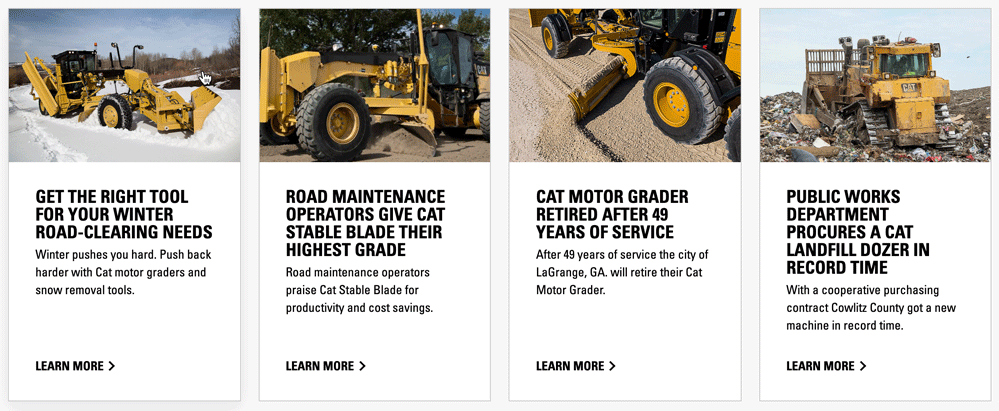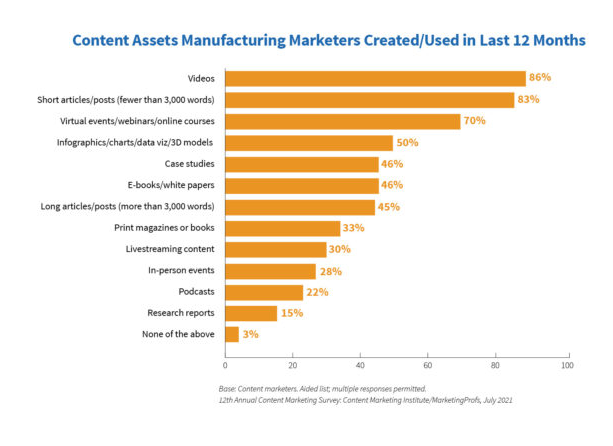Manufacturing is competitive. If you want to stand out from the competition, it’s essential to prove the success of your products and services to prospective customers to earn their business. While developing B2B manufacturing case studies is one of the oldest forms of content marketing, they’re highly effective at illustrating your customer’s problems, solutions, and the end result to build trust with prospects.
Consider discovering what your case studies need to include and how to create impactful content that drives engagement. After all, with 51% of manufacturing marketers saying they struggle creating valuable content that converts prospects, developing case studies is an excellent way to differentiate from the competition.
Ready to learn more? Let’s dive in!
Key Takeaways:
- Case study content focuses on telling a narrative about how your products helped a customer.
- Include statistics, visuals, and quotes to make your content more credible.
- Promote your case studies on digital channels to extend your overall reach.
Do You Need to Create B2B Manufacturing Case Studies?
Think about your current customer base. Most likely, you have hundreds of customers that you’ve helped succeed or grow. While you may have a standard content marketing strategy for blog development, you still need to carve out additional resources to focus on manufacturing case study materials to wow new customers.
In most scenarios, a successful case study will demonstrate a story of an active customer that experienced positive benefits from using or investing in your products. A few benefits of developing manufacturing case studies include:
- Demonstrates your niche to a specific target audience
- Positions your company as an authoritative resource and builds credibility in your industry
- Explains how your company solves specific, real-life problems
- Provides social proof – 91% of online consumers look at testimonials and reviews before making a purchase decision!
- Builds engaging website content and contributes to local search engine optimization (SEO) tactics
- Allows you to repurpose smaller content snippets for social and email channels

Tips for Developing Your Case Study Material
With 77% of B2B buyers in the evaluation stage stating that case studies carry more influence than any other type of content, you need to develop materials that engage with your target audience and help lead generation efforts.
However, a successful case study doesn’t just offer a problem and provide a solution. Instead, it gives detailed storytelling that allows readers to put themselves in the shoes of your customer. While it needs to include well-written summaries and actual quotes, don’t forget to make the story exciting with specific details that pique industry interest.
Here are a few additional tips to make the most out of your content:
- Include statistics through visually appealing diagrams, graphics, and infographics to highlight data-backed social proof
- Make it easy to read and scan with headlines, subheadings, bullets, and bold print to highlight main points
- Test our different formats, like video, Q&A, or blog, and monitor the success metrics
- Refresh your case studies with new imagery and statistics to ensure your materials stay relevant
When creating impactful content, it’s always best to test what works for your target audience to ensure you don’t waste valuable resources and budget. You can do this by constantly analyzing your campaign metrics and optimizing as needed.
6 Steps to Create B2B Manufacturing Case Studies that Drive Engagement
With 46% of marketers developing case studies in the past 12 months, manufacturing brands should leverage success stories throughout the customer journey to attract quality leads. To help you get started, here are the steps you need to take to develop B2B manufacturing case studies:

1. Research Your Buyer Needs
While a case study is a prime inbound marketing asset, it needs to appear at the right time for prospective buyers while they’re in the decision-making stage in the sales funnel. However, to provide real tangible value, you need to understand your prospect’s pain points and position your brand as the solution.
To help you get started, you’ll need to research the industry and buyer type to determine your audience’s needs. You can accomplish this by creating buyer personas, conducting customer interviews, asking for feedback from advisory councils, or analyzing data points in your target channels. When you have a good understanding of current challenges, you’ll be more equipped to develop a storyline that provides valuable insight.
2. Choose the Customer Success Story
Once you understand the buyer’s needs, you’ll need to select a customer success story as the focal point of your content material. While you most likely have several exceptional customers, choose a story that your services substantially impacted the end result.
If this is the first case study that will be on your website, you’ll want to highlight a story that showcases your core products or services. While you don’t need to describe everything you offer, it should mention solutions you’re well known for in the industry and are repeatable for other customers. You can focus on more niche products for future case studies to highlight your variety.
Most importantly, your case study should represent your ideal buyer. You can leverage buyer personas to reach specific audiences to ensure you acquire the right prospects and target their customer journey.
3. Conduct the Customer Interview
Now that you have selected your ideal customer, you need to set up an introductory call to conduct an interview. If you’ve never undertaken a case study interview, here are a few best practices to help you get started:
- Ask open-ended questions so learn more about the customer’s story and receive genuine answers. You can ask specific questions once your customer gets comfortable talking about the impact.
- Avoid making the interview all about your brand and products. Instead, focus on your customer with questions like, “Can you share your team’s recent goals?” or “What feedback did you receive from your customers about our products?”
- Inquire about statistics and data to back up the story. While storytelling makes the content more engaging, numbers will help your sales team back up claims and make your company appear more credible.
- Follow up with the next steps, so your customer understands the expectations and whether you’ll need more information during the content development process.
Depending on the case study theme, consider including cross-functional sales or product teams in the interview so more departments can learn about the customer’s experience. This feedback can lead to improved products or customer service to provide better business results in the future for all customers.
4. Format the Material
While you want to develop your material in a scannable and easy-to-read format, you also need to build a strong story that captures your prospect’s attention. Your case story should include the following elements:
- Start with the Basics: Who is your customer? How did you find your customer? How long have they been your customer?
- Explain the Problem: What were your customer’s needs? What was the customer doing before you started working with them? How did the problem impact their business?
- Illustrate How You Solved the Challenge: What did you provide? Are there hard numbers and statistics to share, like dollars or time saved? Are there any qualitative impacts?
- Include a Call-to-Action: What do you want prospects to do after reading or watching your case study?
When it comes to formatting, focus on providing quality over quantity content. Since modern buyers have shorter attention spans, ensure you get to the point quickly or risk losing their engagement.
5. Develop the Content
Now that you’ve acquired all the information and data, you need to craft a compelling story demonstrating your customer’s complete narrative. Like writing blogs, your case study should avoid any fluff and provide real solutions to help prospects envision their problems.
In terms of the case study design, embrace white space. If you’re missing information, consider utilizing customer quotes, infographics, tables, and numbers to showcase your solutions in more visually appealing ways.
Additionally, since 79% of marketers plan to generate more leads from content marketing, you want to attract online buyers searching for similar problems and push them into your sales funnel. To do so, ensure you include user experience and SEO tactics to match search intent and provide a navigable customer experience.
6. Promote the Case Study
After you’ve developed your case study, you need to promote it to your audience to drive engagement and results. Since creating a successful case study often takes a few weeks, it’s beneficial to develop a promotional strategy ahead of time, so your organization understands how to promote the asset before it’s published.
Case studies are critical inbound marketing tools to drive mid-funnel activity. Here are a few ways you can effectively promote your content:
- Share on social media channels like LinkedIn, Facebook, and Instagram
- Write a blog post that highlights the case study and include the link in existing blogs
- Include the content in email nurtures or monthly newsletters to engage with prospects during their buyer’s journey
- Develop a case study landing page or resource center for website visitors to view your content on their own time
With any marketing campaign, ensure you set up the correct tracking parameters and monitor metrics once the case study is live to analyze performance.
Attract Prospects with Strong Customer Case Studies
Developing B2B case studies is a great way to showcase social proof and highlight your services if you want to build trust and credibility with prospective customers. With the right content strategy, you can amplify case studies throughout the customer journey and help prospects envision how your products and services will solve their problems.
Ready to start creating B2B manufacturing case studies? Get started with Shanahan Strategy Inc.

